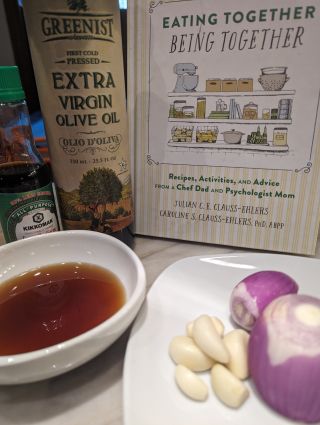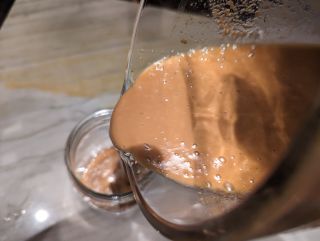Resilience
The Secret to Making Your Kids Like Salad
A Personal Perspective: Food curiosity is a wonderful thing.
Posted June 4, 2024 Reviewed by Abigail Fagan
Key points
- As our children grow and develop, so too does their understanding of themselves and the world around them.
- Reassure that it’s OK and expected to make mistakes such as when trying new foods.
- Food curiosity is important to cultivate.

It’s a familiar story. One we’ve heard a lot and assume you as parents have heard it a lot too.
It’s the "I don’t like salad" story.
While this story goes way back, we can’t help but wonder where it came from. Our 8-year-old son Olliver is a self-proclaimed salad dis-liker. But he’s never even tried salad.
When our girls were in grade school, a wonderful time of get-togethers, dinner playdate drop-offs, were often accompanied with a disclaimer: “We just want you to know, Morgan (a made-up name) will eat the pizza, but she won’t eat the salad.”
Our girls love salad. At ages six and eight, they’d dig right in, pouring on chef dad Julian’s homemade dressing during those playdate dinners.
We discovered pizza goes really well with salad. It’s delicious-to-eat doughy tomato-sauced melted cheese (our book includes a homemade pizza recipe by the way) goes alongside vinegary green freshness.
The crunchy fresh and crusty warmth makes for a combined sharp and smooth flavor that just makes us want to eat more.
There was often a change during those dinner playdates, a twist, so to speak.
Food curiosity is a wonderful thing.
This is the part of the story where friends would look on and wonder. As an onlooking mom I imagined the inner narrative went something like, “Hmmm, it looks like they’re really enjoying the salad with the pizza. Maybe it’s not so bad. Maybe I’ll try it. Just a bit, to see if I like it the way they do.”
Salad served and dressing poured, slowly, slooooooowly, a forkful is raised to try. The inner voice kicks back in, “Whoa, what is this taste? It’s good. Really good. I’ve never had salad like this before. I want more. I want a whole serving with my pizza.”
More than once (I promise), we’d get a lovely call from a parent. We appreciated it was always a call, never a text as it was wonderful to talk about this new discovery and of course, share the recipe.
I guess it’s natural for us as parents to make assumptions. And in fairness, maybe there’s been a predominant response in the past.
Sometimes we don’t know that things are going to change.
Sometimes what we assume is the ending to a story actually turns into a new possibility. A story where we thought our kids would make a certain choice but the experience changed and our kids chose a narrative with a different turn.
Human development is a wonderful thing. As our children grow and develop, so too does their understanding of themselves and the world around them.
Says psychologist and artist Dr. Carolyn Newberger: “Our 'core' selves grow and change, and that change is within a social context that does influence who we are and how we see ourselves. So trying new things and seeing how others see us is part of how we discover our likes, dislikes, fears, joys, capabilities, limitations, and ways of approaching challenges. We hope that our kids will be resilient, creative, brave, and practical. Food is a perfect medium in which these qualities can emerge and be taught.”
One question we can ask as parents is how can we continue to open up new avenues of exploration and growth for our children. If we say, “It’s OK, Morgan won’t eat the salad” we set an expectation. To live up to that expectation, it may very well be that Morgan isn’t going to eat the salad.
Here are some ideas about the possibility of opening up pathways:
Instead of assuming some foods won’t be liked (even if that’s been the pattern in the past), we can check in and ask if our kids want to try something new.
How can we identify and peel back assumptions so that we’re connecting with our kids where they might have arrived at a new moment in time? Perhaps in moments of food exploration and peer modeling as described above, kids want to express their curiosity by trying new foods, even if they haven’t wanted to before.
Reassure that it’s OK and expected to make mistakes such as when trying new foods.
It’s understanding that our kids might respond to situations from the safety of what they know. Opening up options may be fraught with a fear of failure. The question that applies to trying salad might be: What if I don’t like the salad after all? And that’s OK too. “Good for you for trying it,” is something we often tell Olliver when he tries a new food and decides it’s not for him.
Incorporate language around resilience, learning from mistakes, and trusting we can bounce back when things don’t work out as planned.
As parents, we are protective and understandably want to swoop in and make decisions for the young ones in our lives whom we love so much. As a mom, I’ve worked on stepping back and letting our kids make choices for themselves. It’s hard because I don’t want to see them upset if things don’t work out, but I have to believe that learning how to bounce back if things don’t go as planned is an important part of building resilience. Perhaps even more important, I’ve learned that when our kids make calculated risk choices and things do work out, the sense of ownership and confidence is irreplaceable. Being able to take a calculated risk (e.g., here trying salad) builds trust in oneself. Even if we fail, we can learn to recognize that we can recover from failure.
So let’s get back to the salad dressing. What secret ingredient makes it so delectable?
Why it’s maple syrup of course!
Who would have thought that sugary sappiness and tart vinegaryness would go so well with smooth lettuce and all its salad toppings? We guarantee this salad dressing is worth trying-below is our recipe (Clauss-Ehlers & Clauss-Ehlers, 2022).
Top Tip: Our Maple Salad Dressing lasts for many meals. You don’t need a fancy bottle to put it in. We put ours in a big jar and ladle it out with a spoon.
Maple Salad Dressing
INGREDIENTS
1/2 cup maple syrup
1/4 cup red wine vinegar
1/4 cup balsamic vinegar
1/4 cup light soy sauce
1 Tbsp Dijon mustard
1 Tbsp minced shallot
2 tsp crushed garlic
1 cup extra-virgin olive oil
1 cup vegetable oil
fine sea salt and freshly ground black pepper

YIELDS 3 CUPS
In a blender, blend together the maple syrup, red wine vinegar, balsamic vinegar, soy sauce, mustard, shallot, and garlic.
While blending, slowly drizzle in the olive oil and vegetable oil. This will create an emulsion (an oil suspended in a liquid).
Season with salt and pepper.
Keep your dressing in the refrigerator for up to a month and use it as the perfect accompaniment with your favorite fresh salad.
Top Tip: Did you know that olive oil becomes a solid when it’s at a low temperature like being in your fridge? To avoid your Maple Salad Dressing being in solid form when taken out for dinner, be sure to remove it from the fridge about an hour before dinner is served.
Top Tip: Make your salad a summer salad by adding strawberries, blueberries, and blackberries. Then pour on our maple salad dressing for sweet and savory goodness all in one.
References
Clauss-Ehlers, J.C.E., & Clauss-Ehlers, C.S. (2022). Eating together being together: Recipes, activities, and advice from a chef dad and psychologist mom. Princeton Architectural Press.




